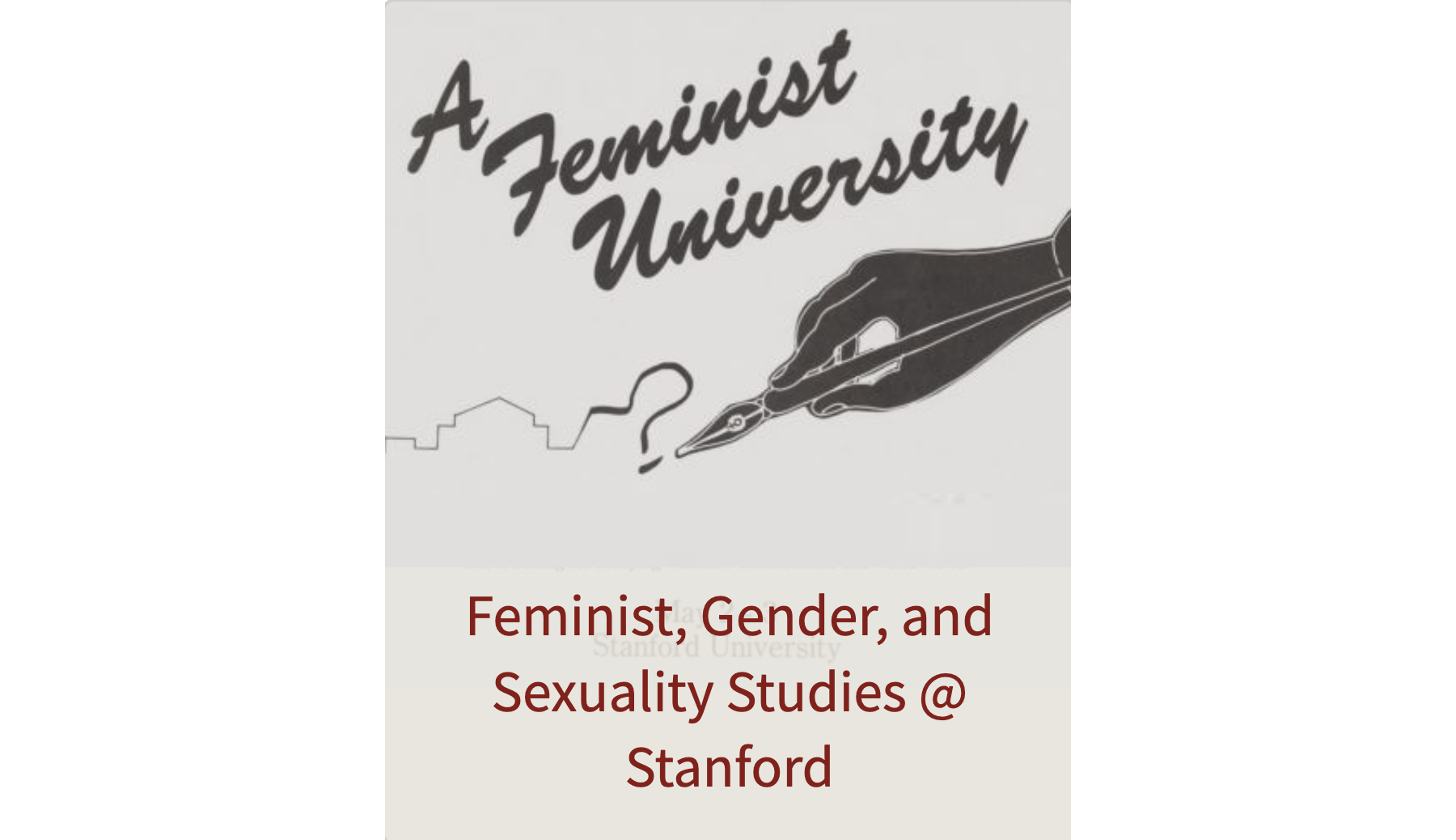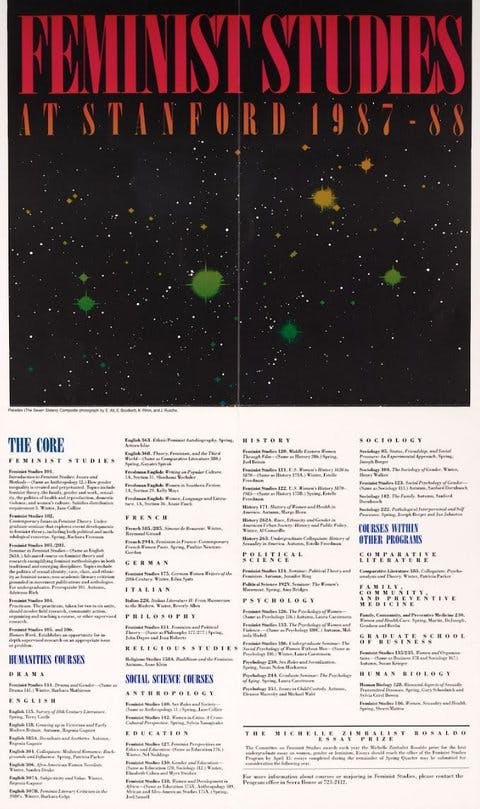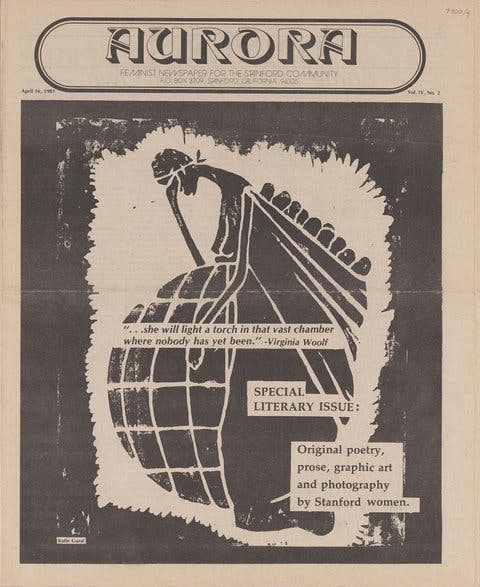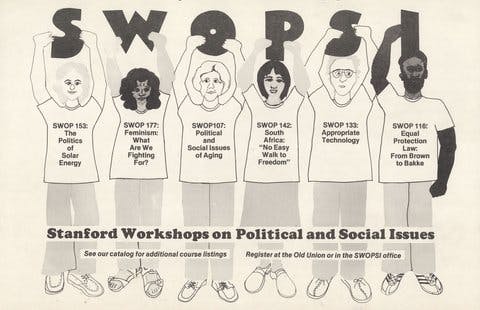
Hi! My name is Hana/Connor Yankowitz, I use they/them pronouns, and I am a Stanford senior majoring in Feminist, Gender, and Sexuality Studies with double minors in Studio Art Practice and Creative Writing. I am also an aspiring archivist passionate about queer studies and speculative graphic storytelling, and I recently created the exhibit, Feminist, Gender, and Sexuality Studies @ Stanford: A History of Local Feminist & Queer Scholarship and Community, for the Stanford University Archives
This exhibit represents the culmination of a year-long research project on the history of the Feminist, Gender, and Sexuality Studies (FGSS) Program, as well as feminist and queer studies at Stanford more broadly. It includes an extensive timeline detailing the history of feminist communities, a variety of categories for browsing digitized archival items, and a list of helpful resources for researchers, plus much more.

When I began this project at the start of summer 2022, working for FGSS at the University Archives under the supervision of University Archivist Josh Schneider and FGSS Associate Director Maxe Crandall, my directive was to conduct research in order to edit a program history begun the previous summer by another FGSS student, Brionna Bolaños. The work would be filling an important niche; a year after the program’s 40th anniversary celebration in summer 2021, FGSS did not even have a list of its own directors on its website, and though there were ten boxes of Feminist Studies Program documents donated to the University Archives in 2002, none had been digitized.
While Brionna’s hard work guided my own investigations, especially near the start of the project, I soon came to realize that the scope of my research would be better served in the form of a multifaceted, multimedia exhibit than a written history, and adjusted my workflow accordingly. My work on the project came to live mainly under three umbrellas: 1) a comprehensive timeline of feminist- and queer-related Stanford events, 2) a massive spreadsheet of feminist and queer studies classes offered at Stanford over the years, and 3) a collection of digitized archival documents to be included in the exhibit.
Over that first summer and the following school year, with financial support first from the FGSS Program and later from the Clayman Institute for Gender Research, I painstakingly combed through the ten boxes of Feminist Studies program materials, performing scanning, conversion, and metadata entry in order to prepare hundreds of historical documents to be accessioned into the Stanford Digital Repository. I learned how much effort it takes to turn a physical piece of paper into a useful digitized document (including searches for author entries in the Library of Congress database, use of Optical Character Recognition programs, and stitching together and pulling apart individual pages in different file formats), as well as the limitations of my own abilities– huge shoutout to the Stanford Digital Production Group for helping me digitize oversize posters!

As I was processing all of this correspondence, committee meeting minutes, newsletters, and event posters, I added their information into my timeline and spreadsheet documents, slowly compiling a history of feminist Stanford communities. I also spent a great deal of time in the library’s already-digitized archives, browsing copies of feminist university publications like Aurora and A Woman’s Guide to Stanford; course posters from programs like the Stanford Student Workshops on Political and Social Issues (SWOPSI); transcripts from the Stanford Historical Society’s Oral History Project; backups of Stanford websites; and local newspapers such as the Stanford Daily, the Campus Report/Stanford Report, and the Bay Area Reporter (all of which, thankfully, have comprehensive, full-text-searchable archives). All of the information from these sources, too, went into my timeline and spreadsheet, and many of these items would end up in the digital collection of the exhibit as well.
This summer, as a student intern in the Clayman Institute’s Susan Heck Summer Internship program, I finally compiled all the research I’d collected throughout the school year and previous summer into a Spotlight exhibit for the library’s website. This involved seeking out visuals to insert into the timeline and feature pages, fleshing out the events on the timeline through extra investigation, and conducting additional research to fill out feature pages on topics such as the CROW Group’s “Victorian Women” class, which was a direct predecessor to the interdisciplinary Feminist Studies Program. I also spent some time reaching out to a number of former Program Directors and Associate Directors in search of information about the Program’s activities in the post-2000 era, for which there was a dearth of archival material.

Throughout my time in the archives, I learned much about the fascinating history of the University and the feminists who fought hard to establish equity for gender-marginalized Stanford students and faculty, and create spaces for both feminist community and gender-based academic inquiry.
A few highlights from my research:
- Women students were not allowed to wear pants in central campus into the 1960s– instead, they were required to wear “Quad clothes,” meaning skirts.
- Gay rights activism by student groups on campus dates all the way back to 1965, when the Stanford Sexual Rights Forum began to advocate for job protection for gay people as well as the decriminalization of homosexuality.
- The first co-educational living space for undergraduates, Grove House, became mixed-gender in January 1967.
- Many early women’s studies classes occurred under the auspices of Women’s Center (not for credit) or the Stanford Workshops on Political and Social Issues, aka SWOPSI (for credit).
- The Stanford Gay Students Union, which would become today’s Queer Student Resources center, was founded in 1970– the same year that the Big Game Week Gaieties show featured a gay main character for the first time.
- Both the return of sororities to campus after a decades-long ban and the lifting of Jane Stanford’s cap on women’s enrollment were direct results of the passage of Title IX.
- A strong pillar of the Center for Research on Women (CROW) in its early years as one of the first university women’s studies centers was the visiting and affiliated scholars program, which ran from 1977 to 2005. The program allowed non-faculty academics to engage in the interdisciplinary feminist scholarly community at Stanford, sharing their work and forming connections which eventually led to a number of groundbreaking publications. The affiliated and visiting scholars acted as the public face of the center, and did everything from running CROW’s quarterly newsletter to organizing conferences.
- The Program in Feminist Studies was created by members of the Center for Research on Women in 1981 after its Task Force for the Study of Women concluded that such an academic program was needed. The development of the program out of a research organization is unusual, since many similar programs (both at Stanford and other universities) were founded directly out of student activism in opposition to University institutions.
- Carolyn Lewis Attneave House, formerly known as Serra House, was originally built as a retirement home for first Stanford President David Starr Jordan. The building, which currently houses the Clayman Institute and used to host the Program in Feminist Studies, was moved across campus twice during its history, since the University regarded it as having too much historical significance to destroy.
- Gender Studies was a part of the undergraduate distribution requirements from 1991-2005, thanks to the efforts of Feminist Studies faculty.
- The 2013 name change of the Program in Feminist Studies into the Program in Feminist, Gender, and Sexuality Studies coincided with the Program’s move from Serra House to Margaret Jacks Hall and the inauguration of its Ph.D. minor program.
I am incredibly grateful to have had the opportunity to work in the Archives, learning about and compiling the feminist/queer history of Stanford University, and my immense appreciation goes out to the wonderful folks at the University Archives, Clayman Institute, Program in Feminist, Gender, and Sexuality Studies, and beyond who helped me make this dream a reality. (A fuller list of acknowledgements can be found in the FGSS@Stanford exhibit.)

Looking toward the future, there are a few updates I am hoping to implement in the Fall. These include a number of recently acquired digital archival materials, an interactive map of feminist communities on campus, and my spreadsheet of feminist classes. In an ideal world, I would also love to give the same time and attention to digitizing the University Archives’ Clayman Institute collection as I was able to give to processing the Feminist Studies collection (though this work would also make a wonderful internship project for another student passionate about archives and gender studies).
Hana/Connor Yankowitz ('23) is a recent Stanford graduate who studied queer art, culture, and history in the Feminist, Gender, and Sexuality Studies Program at Stanford University. They have previously written about their experiences working in the Archives in a February 2023 blog post and a March 2023 blog post.
Note on Name Changes
Both the Program in Feminist, Gender, and Sexuality Studies and the Michelle R. Clayman Institute for Gender Research have gone through name changes since their inception. Though I most commonly use their current names, they may also be referred to as the Program in Feminist Studies (FemStud) and the Center for Research on Women (CROW)/the Institute for Research on Women and Gender (IRWG), respectively, depending on the historical timeframe.)
About the Stanford Archives
The Stanford University Archives collects, preserves, and provides access to content in any format that documents the history of the university, in support of teaching, learning, and research at Stanford and beyond. Please contact us if you would like to share materials with us, work with us, or if you have any questions about using the collections.